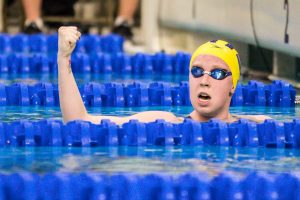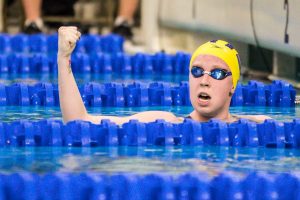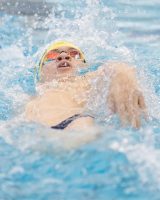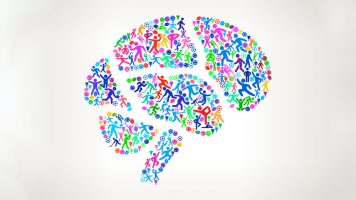A pair of Athletes Connected team members were quoted and contributed to this Michigan Health Blog story that examines how sports icons like Simone Biles and Naomi Osaka could accelerate growing acceptance and decreasing stigma for mental health.
 By Kara Gavin
By Kara Gavin
They had the world’s spotlight shining on them.
They had trained for years for this moment.
Millions of fans waited to watch them compete and see them hoist a trophy or a gold medal once again.
Instead, they used that spotlight to say something few world-famous athletes have ever dared to say out loud: I need to step away from this competition and focus on my mental health.
And by doing so, gymnast Simone Biles, tennis player Naomi Osaka, basketball player Kevin Love and a handful of others at the pinnacle of their athletic careers have helped accelerate a trend that mental health experts at the University of Michigan say is long overdue.
“As more athletes speak out, it gives others permission to ask for help and normalizes mental health as part of the conversation,” –Stephanie Salazar, M.P.H.
By being open about what they were experiencing, and not “toughing it out” or stifling their feelings like generations of athletes have had to do, these icons did more than spare themselves injury or defeat.
Their public choice to seek help for depression, anxiety, overwhelming stress and other concerns could help athletes at all levels have the courage to seek professional help, and a break from competition if they need it.
U-M experts who work with athletes on mental health awareness and care had already started to see the shift toward this growing acceptance, even before the news broke from Wimbledon about Osaka or from the Tokyo Olympics about Biles.
Victor Hong, M.D., directs the psychiatric emergency department at University of Michigan Health, part of Michigan Medicine, and treats students including athletes at the University Health Service. He welcomes the newfound attention to the issue because of Biles and Osaka.
So does Will Heininger, who used to be an elite student athlete himself, playing football for U-M’s legendary Big Ten team while battling depression. Now, he’s the outreach coordinator for the Eisenberg Family Depression Center, and works with Athletes Connected, a collaborative program of Eisenberg Family Depression Center, U-M Athletics and the U-M School of Social Work.
Athletes Connected offers online resources for athletes anywhere, at any level. These include videos of athletes telling their own stories and sharing coping tips, signs and symptoms to look for regarding mental health, skills and strategies for mental wellness and information on how to find a mental health professional.
“As more athletes speak out, it gives others permission to ask for help and normalizes mental health as part of the conversation,” said Stephanie Salazar, M.P.H., who manages outreach programs for the center including Athletes Connected.
 A generational effect helping to end stigma about mental health
A generational effect helping to end stigma about mental health
All three U-M experts say the shift has been most striking as athletes from Generation Z have reached elite levels – including Biles and Osaka.
“The generational difference is one of the things that gives me the most hope about the future – for all of society, not just athletes,” said Heininger. “The idea of ‘not knowing about depression or anxiety’ seems so foreign to them; they are consistently surprised, even shocked, to learn that ‘not knowing’ was the norm, very recently, as well as for all of history before that.”
“Athletes Connected has worked hard over the past seven years to break down the stigma of student-athlete help-seeking at U-M, and over that time, I’ve seen a huge shift in the ways that student-athletes talk about and champion the notion of taking care of their mental health as part of their overall wellness,” Salazar said. “Students are now taking the lead.”
But around the nation and world, young athletes often face resistance or denial from parents and coaches, who come from generations that didn’t know as much about mental health or talk about it.
“Younger people today are more open, and less stigma-driven, when it comes to discussing symptoms they’re experiencing,” Hong said. “But at the same time, they have more pressure on them than previous athletes, because of social media, increased academic demands and the rising cost of college that makes athletic scholarships even more important financially.
“They can feel like they’re letting everyone down if they don’t stick it out,” he said. “But at least they feel more empowered to talk about what they’re feeling.”
Younger people have grown up in a time when research has shown the role of risk factors such as family history, childhood trauma, poor sleep and acute stress in increasing the chances that a person could develop a mental health condition. There’s also a better understanding of how the adolescent and young-adult years are prime time for the onset of many mental health conditions, from depression to schizophrenia.
The importance of early recognition and effective treatment, and the availability of options including telehealth-based talk therapy and mobile apps for monitoring and managing moods, have all converged in recent years too.
 The brain is just a body part
The brain is just a body part
Coaches and parents who heed this research can actually help athletes harness current knowledge to boost their performance, said Heininger.
“The idea that an athlete – or anyone trying to perform at their peak – need not pay attention to their mental health is negligent,” he said. “It would be the equivalent of ignoring their physical health and saying ‘My body just is what it is. There’s no impact if I lift weights, train, and eat well.’ I think it says a lot about how far we’ve come that today’s athletes think about training their minds in the ways they do their bodies.”
Sending an athlete back into competition with a serious injury or concussion has become taboo, because of what we now know about the potential ill effects of stressing an already damaged joint or brain. But that transition hasn’t yet happened for mental health.
Heininger describes it to U-M student athletes this way:
- You need your (blank) to function successfully as a student-athlete.
- If your (blank) isn’t functioning properly, it will be more difficult to get to class, learn the material, perform on tests, succeed in your sport and so on.
- If that blank was filled in with ‘hamstring,’ ‘back,’ ‘lungs’ or ‘foot’ or any body part, coaches and trainers would want to help you figure out why it’s not functioning properly. We’d be proud of you for noticing how it was impacting you. We’d also want to help you get better so you can achieve your many goals.
- When the word that fills the blank is your brain, we believe you deserve the exact same kind of guidance, support and care you would get if it were any other part of your body.
The importance of reaching out about mental health concerns
When an athlete is having a mental health crisis – such as the anxiety attacks that led Love to suddenly leave a Cleveland Cavaliers game in 2018 – coaches and parents need to understand that this is not a time to tell them to “suck it up”, Hong said.
“Continued education for all coaching staff and families, as well as athletes, is so important, so that they understand what’s happening if a crisis occurs,” he said.
When he’s treating an athlete for a mental health emergency, from anxiety attacks to suicide attempts, he often finds himself doing that educating as a crash course. “We can reach them sometimes, but with some families, it can be really hard,” he said.
Heininger remembers being one of those student athletes who didn’t understand what he was experiencing, or what he should do about it, back when he was a defensive lineman for the Wolverines a decade ago.
“After my freshman year, it was my brain that was not working properly. Yet I had no idea that was the case because I’d never heard of depression or even anxiety at that point,” he said.
“Thanks to the incredible care, education, support and treatment I got at Michigan, I went from being a severely depressed 19-year-old who was unsure life was worth living, to a starting player, academic award winner, Michigan graduate, and most importantly, a well-balanced individual who felt ready to take on whatever life brought my way,” he continued. “I got there not because I knew everything. Not even close. But because I’d learned how to ask for help.”
Now, he finds himself hearing from athletes who heard his presentations. Months later, they contact him to get advice – not just for anxiety or depression, but for other emotional and mood changes they’ve noticed in themselves.
For instance, he tells the story of a young man who came to him because he was used to feeling like a “10” all the time, but had been experiencing agitation and anger and was feeling like a “7.”
“If someone doesn’t get help, that 7 can become a 6, and 5, and a 2, and a 1…and become very costly and very tragic, both for the individual, and for the team or organization,” Heininger said. “Instead of hiding it or being silent, he noticed and took action. And then excelled. That 7 went back towards the 10, instead of the other way.”
Hong adds that there is a special significance to the two world-class athletes who have spoken up recently and very visibly. “It is known that in the United States that those from racial minority groups are less likely to seek mental health care than white Americans, with stigma being a significant factor,” he said. “It is then even more notable that Simone Biles and Naomi Osaka, as faces of Black and Asian America, are speaking out, demonstrating that it is ok to admit to having a mental health issue.”
More progress needed to end mental health stigma
The negative comments on social media about Biles’ withdrawal and Osaka’s early defeat during the Olympics have shown there’s still a long way to go in raising awareness and increasing acceptance.
But a growing number of comments are from people defending the athletes for their bravery and cheering on their recovery. Biles even mentioned that Osaka’s decision to focus on her mental health helped inspire her own decision.
“The more people who are famous and come out publicly about their mental health, the better,” Hong said. “Backlash will happen, but somewhere out there we know there are young athletes who sought help because a role model spoke up, and we know that will continue.”
Read the rest of the story on the Michigan Health Blog.










 By Kara Gavin
By Kara Gavin